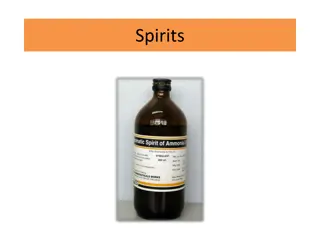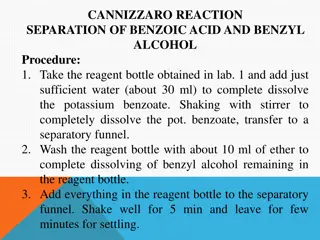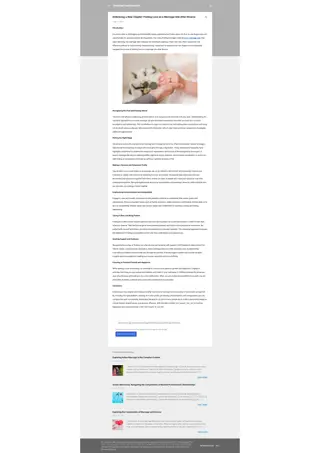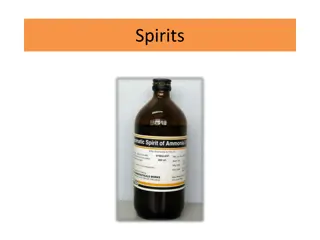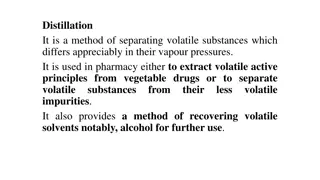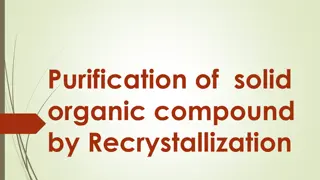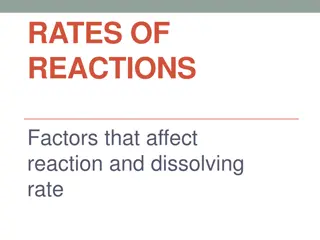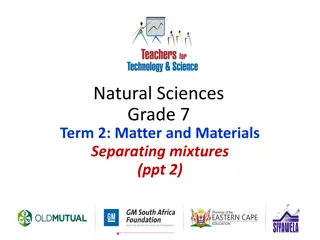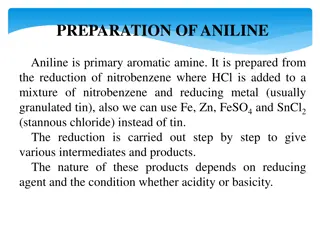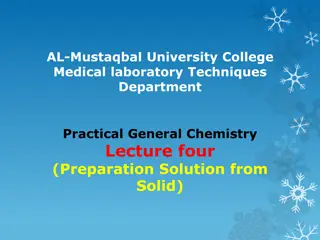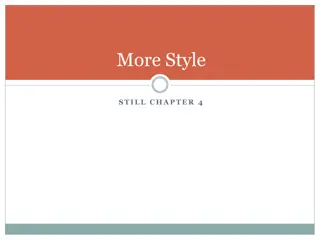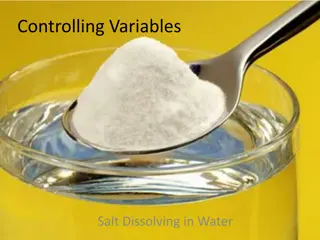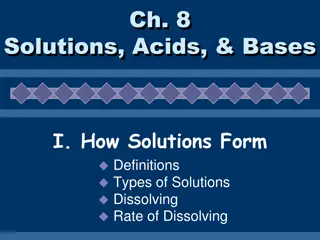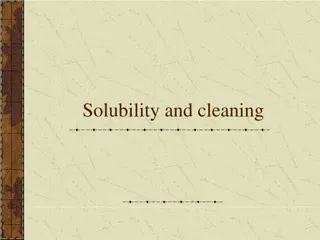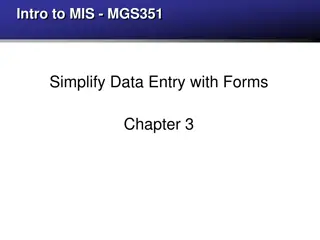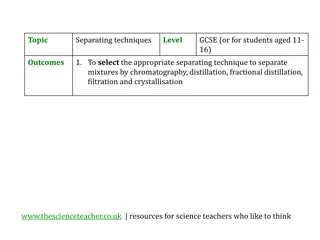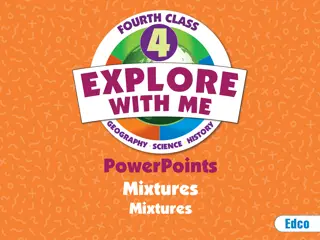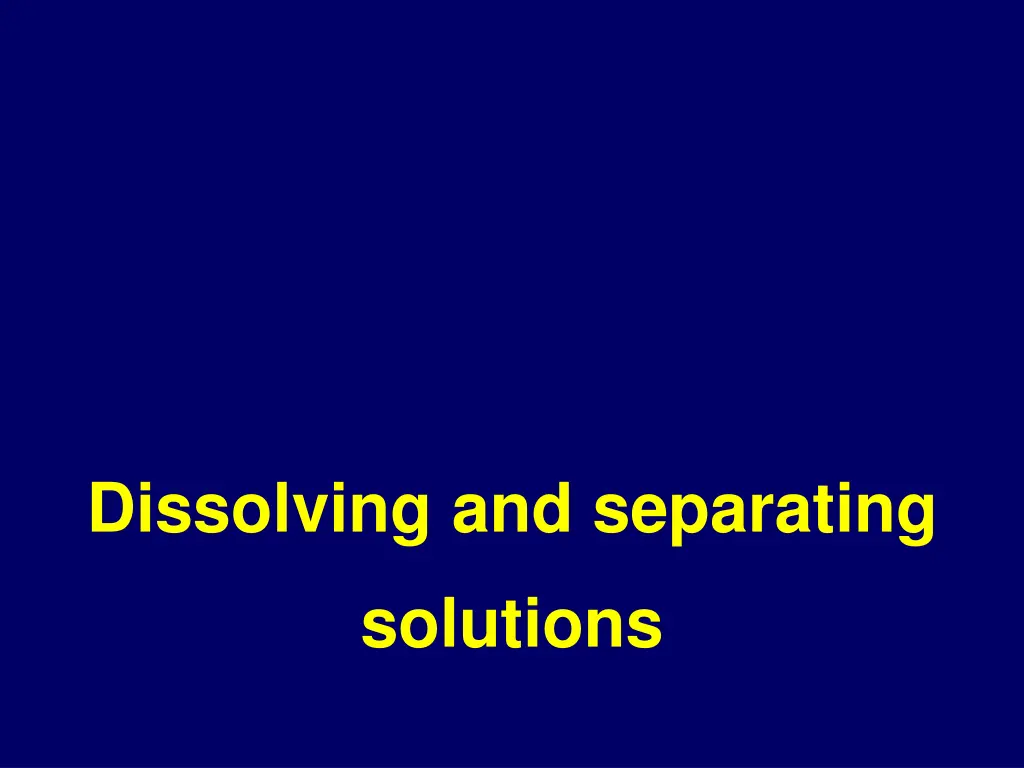
Understanding Dissolving and Separating Solutions in Chemistry
Learn about the process of dissolving and separating solutions through filtering and evaporation. Discover how to transform cloudy liquids into crystal clear solutions and remove dissolved solids using distillation methods.
Uploaded on | 1 Views
Download Presentation

Please find below an Image/Link to download the presentation.
The content on the website is provided AS IS for your information and personal use only. It may not be sold, licensed, or shared on other websites without obtaining consent from the author. If you encounter any issues during the download, it is possible that the publisher has removed the file from their server.
You are allowed to download the files provided on this website for personal or commercial use, subject to the condition that they are used lawfully. All files are the property of their respective owners.
The content on the website is provided AS IS for your information and personal use only. It may not be sold, licensed, or shared on other websites without obtaining consent from the author.
E N D
Presentation Transcript
Dissolving and separating solutions
Dissolving model Solute Solution Solvent
Filtering Glass rod Filter paper Cloudy liquid Filter funnel Filtrate
Filtering What does filtering do to a cloudy liquid? it makes it crystal clear What does filtering remove from cloudy liquids? insoluble materials Why will filtering not remove any dissolved materials? dissolved particles are all separate from each other they are able to pass through the tiny holes in the filter paper, as do the liquid particles
Filtering model insoluble particles are unable to pass through the tiny holes in the filter paper How does filtering work? Filter paper Solvent particles Dissolved particles Insoluble particles
Filtering and dissolving key words Key word Explanation Soluble Solvent Insoluble Solute Filtrate Solution Saturated Solid that will not dissolve Insoluble Soluble Solvent Solution Solute Solid that will dissolve Liquid that will dissolve solids Liquid with dissolved solid Solid that has dissolved Filtrate Saturated Clear filtered liquid Solution that is full up
Evaporation and distillation What happens when a liquid evaporates? it changes from a liquid to a gas What happens to any dissolved solids in the liquid? dissolved solids get left behind What happens during distillation? a liquid is first evaporated by heating then cooled to change it back into a liquid What is distillation used for? to remove dissolved solids from liquids
Evaporation model Dissolved particles Solvent particles What happens to the dissolved solid particles? forms into crystals dissolved solid gets left behind and Solvent vapour Heat Heat
Using a Leibig condenser Thermometer Reading? 100OC Cooling water jacket Steam Boiling inky water What is in the Steam Distillate (pure water) bubbles?
Evaporation and distillation key words Key word Explanation Evaporate Evaporate Condense Vapour Distil Distillate Change from a liquid to a gas Evaporate Change from a gas to a liquid Condense An evaporated liquid (a gas) Vapour Purifying a liquid by first evaporating then condensing A distilled liquid Distil Distillate
Fractional distillation What is fractional distillation used for? to separate a mixture of two or more liquids How does fractional distillation work? it can separate a mixture of liquids that have different boiling points the mixture is slowly heated until the liquid with the lowest boiling point starts to boil off from the mixture and is collected by condensing it
Chromatography What is chromatography used for? to separate a mixture of dissolved solids How does chromatography work? the different chemicals in a mixture of dissolved solids have different size particles when dissolved in a liquid, these different sized particles travel through special paper at different rates and so separate out
Strip chromatography model Chromatography paper Solute A Solute B Mixture of solutes A & B Solvent
Chromatography problems Which two samples were probably the same? Which was a mixture of two materials? Samples A and D; they both moved the same distance so they are probably the same because it separated out into two spots Sample B was a mixture of two materials Chromatography paper Start reference mark Test sample A B D C A B D C Solvent
Drop chromatography model Chromatography paper Solute A Solute B Mixture of solutes A & B Solvent added a drop at a time
Predicting chromatography results What separate pigments may be observed? The primary pigments yellow and red mix to make orange
Predicting chromatography results What separate pigments may be observed? The primary pigments blue and red mix to make purple
Predicting chromatography results What separate pigments may be observed? The primary pigments yellow, red and blue mix to make black

